Not content to be on of the leaders of alloy boat building in New Zealand, Surtees have given much of their range a full revamp. Freddy Foote heads along to check out the newly released 610 Gamefisher Hardtop.
Over the last few months, the entire Surtees range has undergone a revamp, essentially every model in the line-up getting a revised look and a few changes.
A reasonable undertaking from a company who by their own admission was doing very well with their models as they were.
The majority of models in the Surtees range have grown slightly in length. The popular 485 now the 495. The 5.5 is now the 575, the 5.8 is now a 610, and the 6.1 is now a 650.
The 610 Gamefisher is based on what was the widely successful 610 model. The boat is largely the same; the key difference is that the company has extended the transom by 150mm and redesigned the hull accordingly giving it a shallower entry angle.
“The feedback from the customers on the 5.8 was that they loved it, but just wanted a little more deck space. So we built one, the response was good, so we continued it into full production,” says Surtees Boats Marketing Manager Adam Dyck.
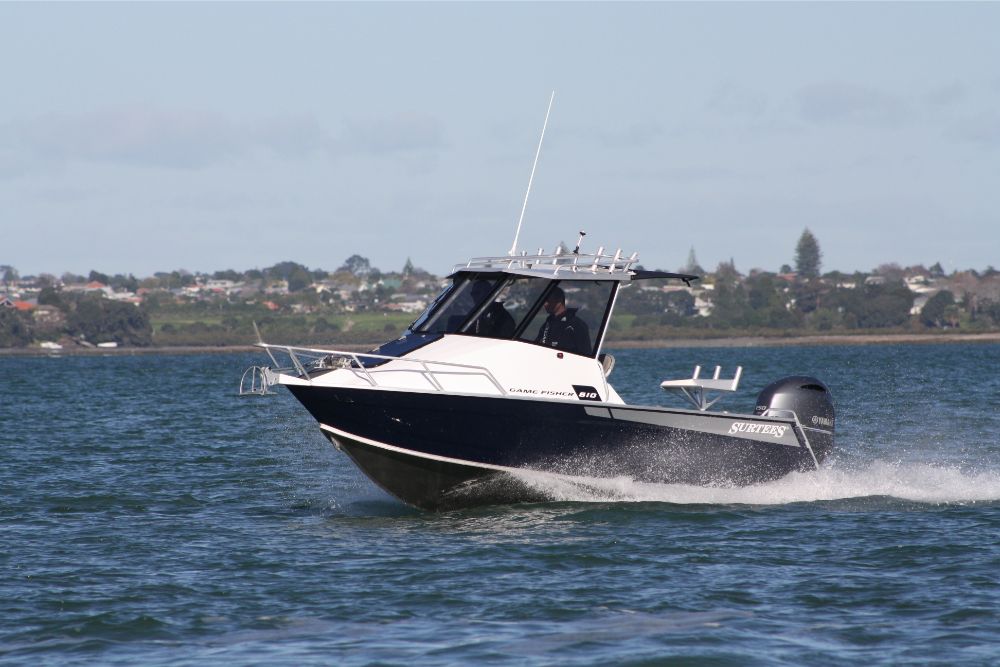
Innovators
Like all other Surtees models, the 610 has the company’s famous ballasted keel. This ballasted keel system on the 610 model can hold 340L (340kg) of water ballast.
Open the adjustable ballast gate up when at rest and it makes the boat ultra stable by bringing in all of that 340L of water ballast. Once underway it will drain out, or lock it in to add some extra weight to the boat for rougher conditions.
As with all other Surtees boats I’ve tested in the past, which is almost the whole range now, the 610 is designed to be non-pounding, stable and comfortable. Surtees says that the smooth ride is the result of combining three innovative design features – the Surtees non-pounding super deep V hull, the ability to carry water ballast in rough conditions, and the ultra strengthened deck system.
Surtees fully welds the stringers to the hull – they are not stitch-welded. The chequer plate floor is also fully welded as are the gussets. The strongest part of the boat is under the floor where you can’t see it – if that doesn’t move, the rest of your boat isn’t going to move.
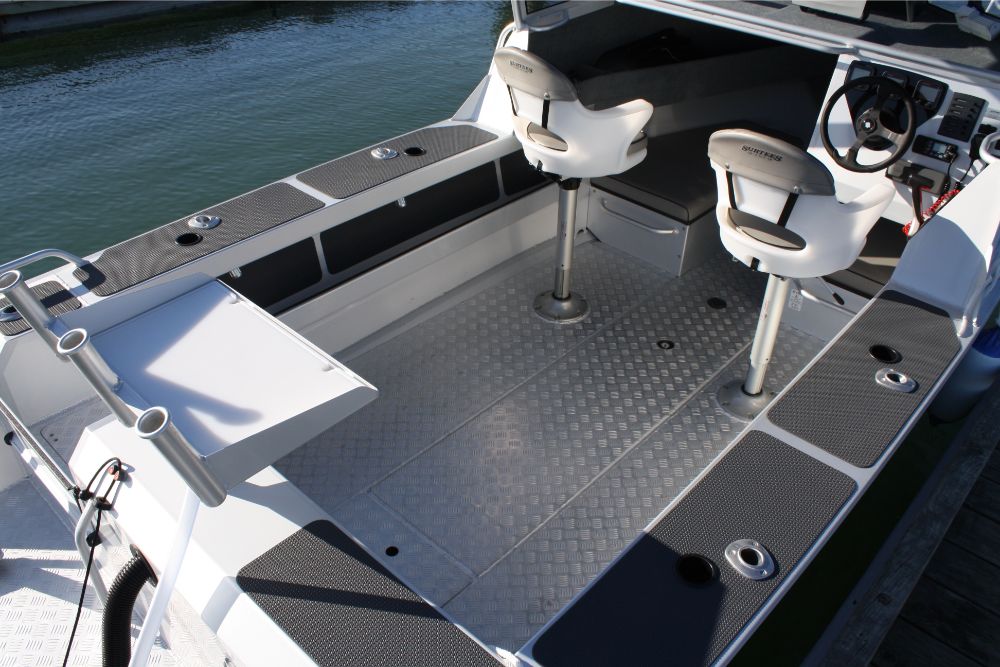
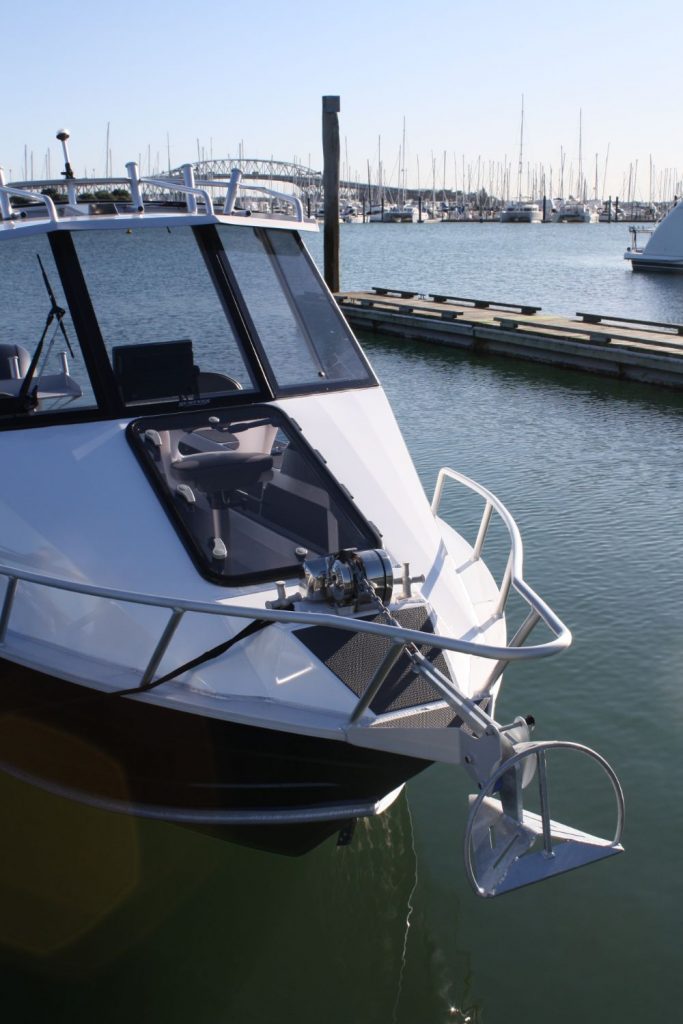
Fisherman Friendly
The canopy comes as an option and is easily fitted and removed. It is certainly a must if you are going to spend long periods of time out on the water under the sun or rain.
With a distinct focus on fishing, there is plenty of provision and amenities for a big day of action on the water. The 610 features 16-rod holders, a full transom with boarding platforms and a ladder – all as standard.
Having been out on a 5.8, I really could notice the extra cockpit space that the 610 now has over its predecessor. Previosuly you would have fished three comfortably, now you’ll happily be able to accommodate a fourth angler. Though some might still prefer to have three onboard with that extra bit of room to work.
Forward in the spacious cabin there is plenty of room to store gear away for the day.
Pockets along the sides of the cabin keep things up and out of the way.
Further storage is available under the bunks as well as housing the optional electric flush toilet, and the large stand-through plexiglass hatch above provides access to the anchor locker. However, anchoring can be done from the helm.
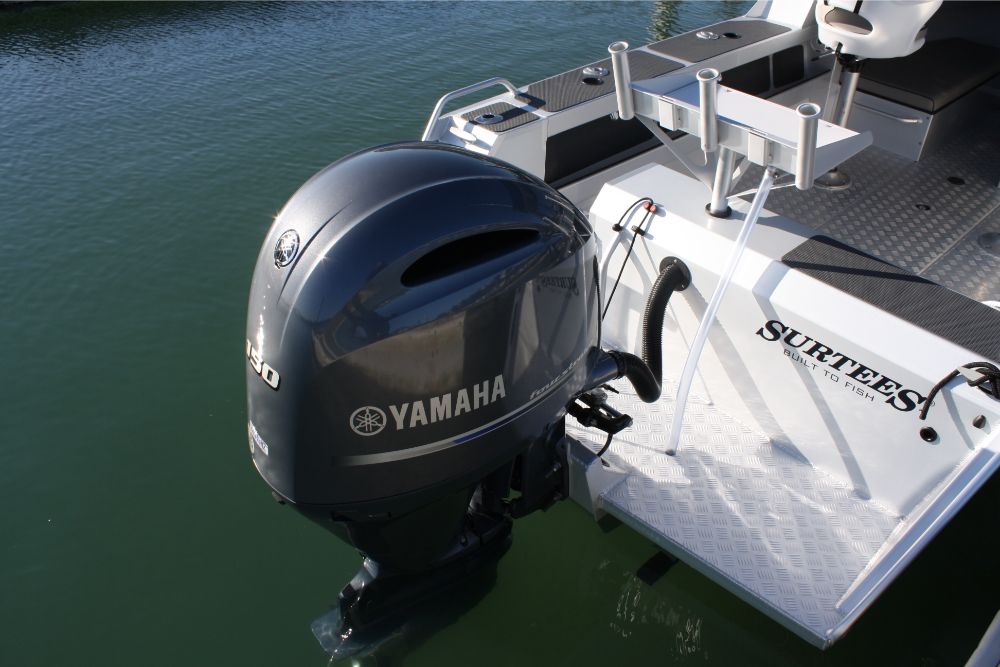
Our test boat came fitted with the optional adjustable pedestal seats, with the standard seating foldaway helm seats. These create a practical layout to maximise cockpit space for fishing, and an underfloor locker provides plenty of storage.
Extra passenger seating can be ordered from the factory, in the form of moveable seats designed to slide along the cockpit shelves so you can sit where you like. If you don’t want them, they can be easily removed and stored out of the way in the cabin.
Additionally, the hatch for the battery compartment in the transom drops down to form a bench seat – a great feature.
Aft, the cockpit boasts nice wide coamings featuring four recessed alloy rod holders and a handy cup holder on each side. What I have always liked on previous Surtees boats, is that the cup holder also doubles as a handy place to hold your sinker when re-baiting lines.
Cockpit side pockets offer further storage for longer items, and a sizable rocket launcher above provides plenty of additional rod storage. Though they are high, you can easily stand on the coamings to lift the rods down.
An underfloor 150-litre fuel tank takes care of fuel storage, leaving enough room for the sizeable underfloor storage compartment, which can be filled with water and drained.
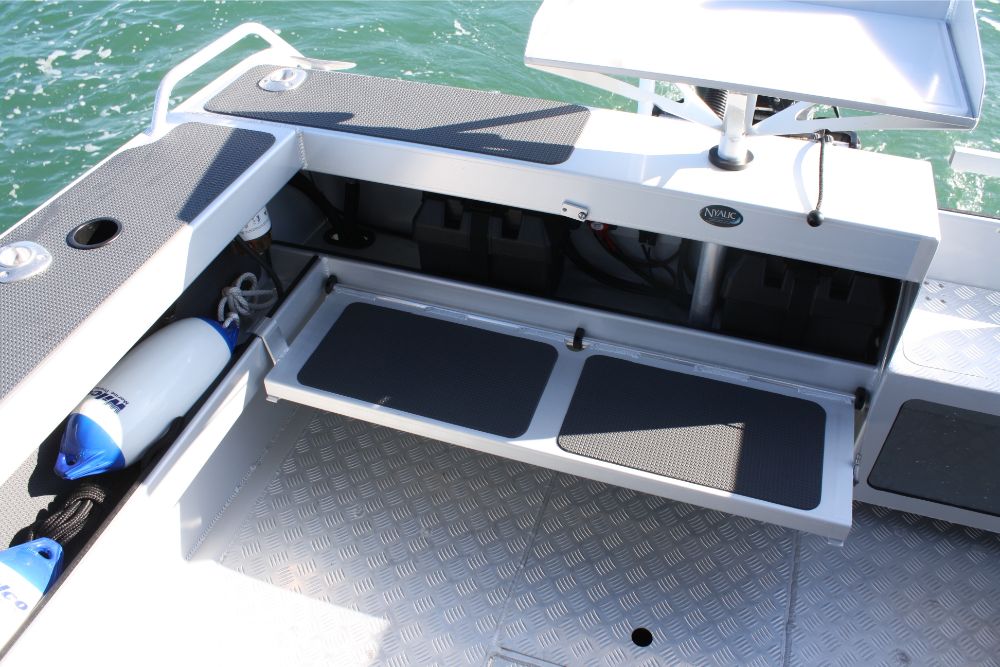
The walk-up-style transom is definitely targetted at fishermen. A large bait station is a prominent feature of the transom while boarding platforms on both sides of the outboard provide access into the cockpit. The port one featuring a sturdy drop-down ladder.
A live bait tank is located underneath the low-profile walk-through in the port corner. The walk-through can be closed off with a drop in door and a non-skid chequer plate floor runs throughout the entire internal deck.
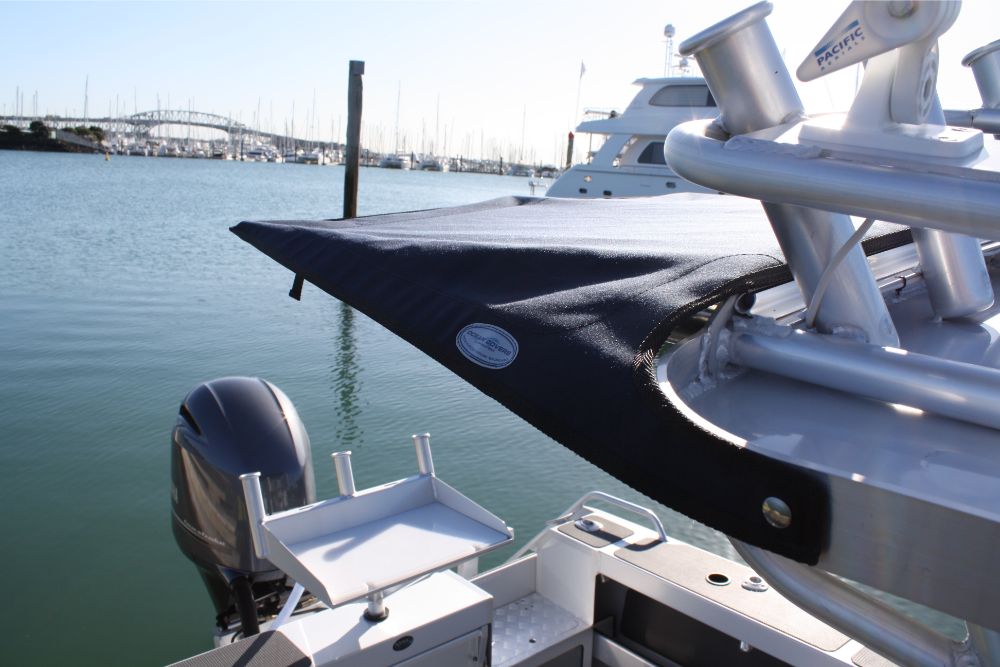
Performance
Our test day conditions on Auckland’s inner harbour were fairly choppy and quite perfect for boat testing. Underway you could get a feel for the variable 19-degree fine-entry hull, making short work of the choppy conditions.
The hull handled everything we could throw at it, a following sea, head on chop, quartering sea, the works; it did very well.
We stopped momentarily and allowed the ballast tank to fill, which takes about 30 seconds. Close the door off, and 340 litres is trapped in the chamber.
With the ballast weight captured underneath it helped us to push through the rough stuff, you could notice the difference it made. It made the boat feel a lot heavier and solid.
Add to that, it makes the boat rock solid and stable when at rest. We tested the stability as best we could, with three on one side of the boat, sure there was a bit of lean, but nothing that would make you feel unsafe.
At the helm, the seating position is quite comfortable, with the throttle controls within easy reach and a well-positioned footrest below. The dash is minimal but practical and has enough room above to mount your preferred electronics package on the large carpeted area above the dash itself. Our test boat was fitted with a large Garmin 7410 XSV MFD.
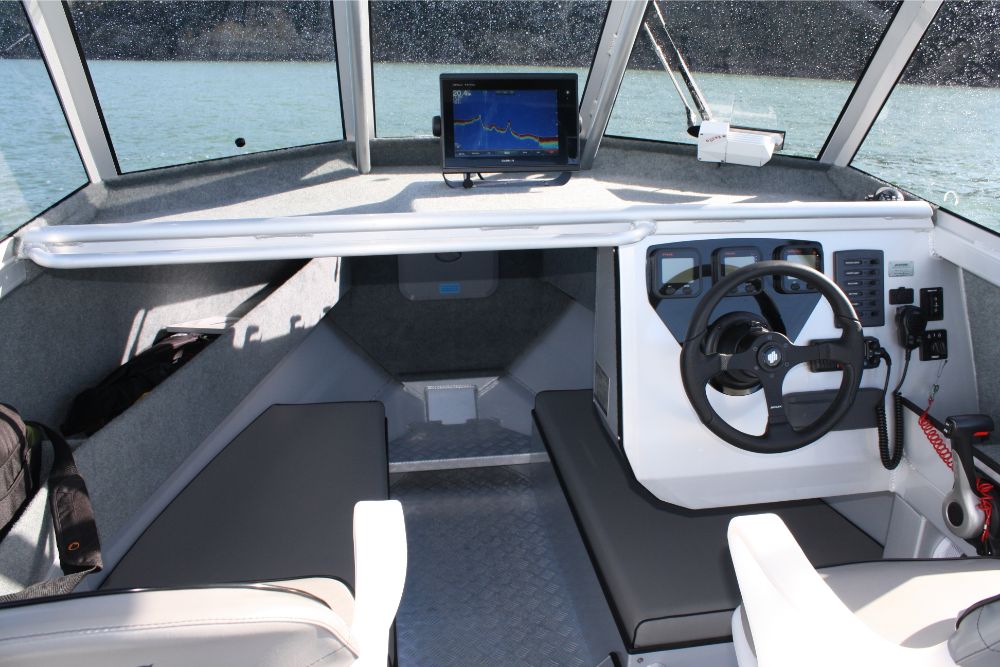
The hull is rated for outboards from 115hp through to 150hp, with our test boat being fitted with a Yamaha 150hp four-stroke outboard. For those who may wish to turn their 610 Gamefisher into just that, a Gamefisher, a trolling speed of 7 knots at 2000rpm will use just 7.9 lph when powered with a Yamaha 150hp four-stroke outboard.
At a comfortable cruise speed of 20 knots @ 4000rpm, it was consuming 20.0 lph. Hit wide-open throttle and it does 40 knots @ 5900rpm and uses 60.0 lph.
Back at the ramp, like all Surtees, the 610 has a clever catch system on the trailer which enables you to drive the boat up onto your submerged trailer and drive forward until the hook, built into the bow, catches the latch on the trailer.
Overall
I’ve always been very impressed by the build quality, attention to detail and finish of every Surtees boat I’ve been on, they have always been one of the more innovative brands on the market.
Next to the smaller 4.85 model (now 495), the 580 was one of the company’s biggest sellers, and it’s easy to see why. Now with the evolution into the 610, there is no reason the new model won’t continue that tradition.
It is well appointed, has heaps of room, plenty of features, many of which are all standard but yet also offers and extensive options list for owners to customise their perfect vessel.

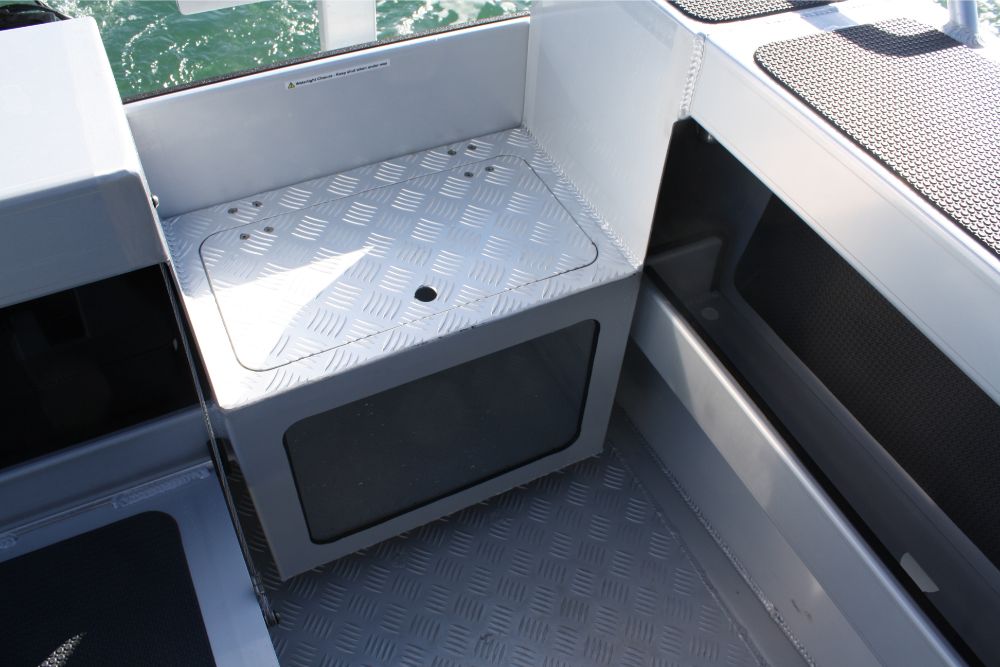
Specifications
- Model & Model: Surtees 610 Gamefisher
- Priced from: $62,000
- Price as tested: $86,000
- Type: Hardtop
- Construction: Aluminium
- LOA: 6.1m
- Beam: 2.26m
- Deadrise: 19 degree
- Height on trailer: 2,95m
- Trailerable weight: 1300kg
- Test Power: 150hp
- Propeller: Reliance 17”
- Power options: Outboard
- HP Range: 115-150hp
- Fuel Capacity: 150L
- Trailer: Single axle
Notable Standard Items
Toughened 4mm tinted glass windscreen, full graphics, boarding ladder, ballast close off flap, battery box, battery isolation switch.
Notable Options on Test Boat
Garmin 7410 XSV, Windlass anchor winch, dual battery system, interior cabin/roof LED lighting, windscreen wiper, Walk Through – Live Bait Tank, 2 x Softrider Pedestals, extended cockpit canopy.
RPM | Knots | L/h | L/NM | Range (NM) |
1000 | 4.5 | 3 | 0.670 | 200 |
1500 | 6.0 | 5 | 0.840 | 160 |
2000 | 7.5 | 7.9 | 1.100 | 120 |
2500 | 9.0 | 11.3 | 1.300 | 100 |
3000 | 16.0 | 16 | 1.000 | 130 |
3500 | 20.0 | 20 | 1.000 | 130 |
4000 | 24.0 | 25.7 | 1.100 | 120 |
4500 | 30.6 | 30 | 0.990 | 130 |
5000 | 32.5 | 36 | 1.200 | 110 |
5500 | 36.0 | 47 | 1.400 | 96 |
6000 | 40.0 | 60 | 1.500 | 90 |




